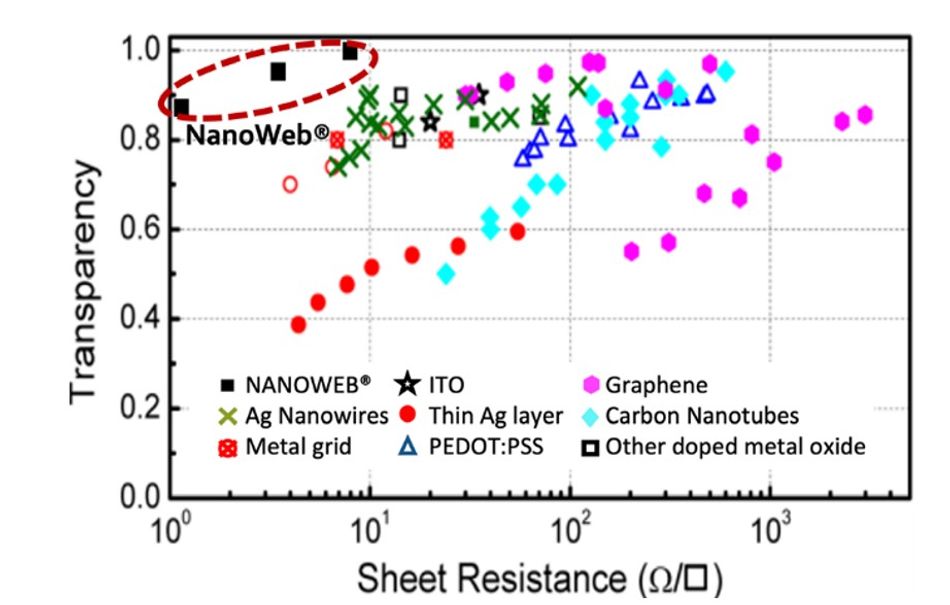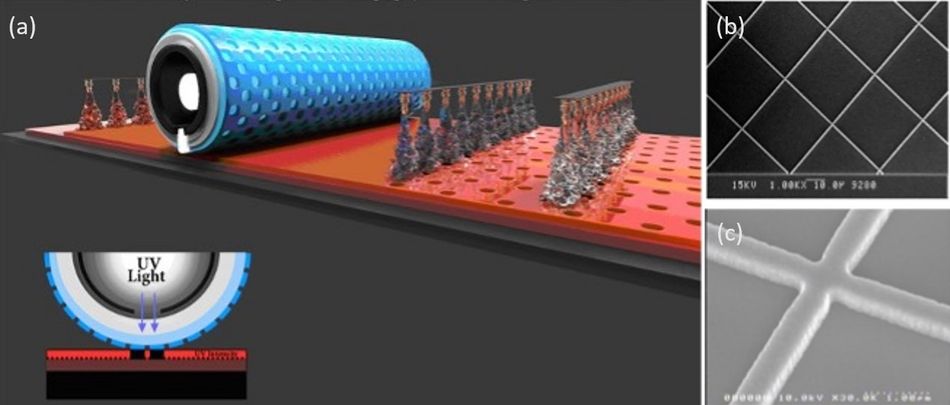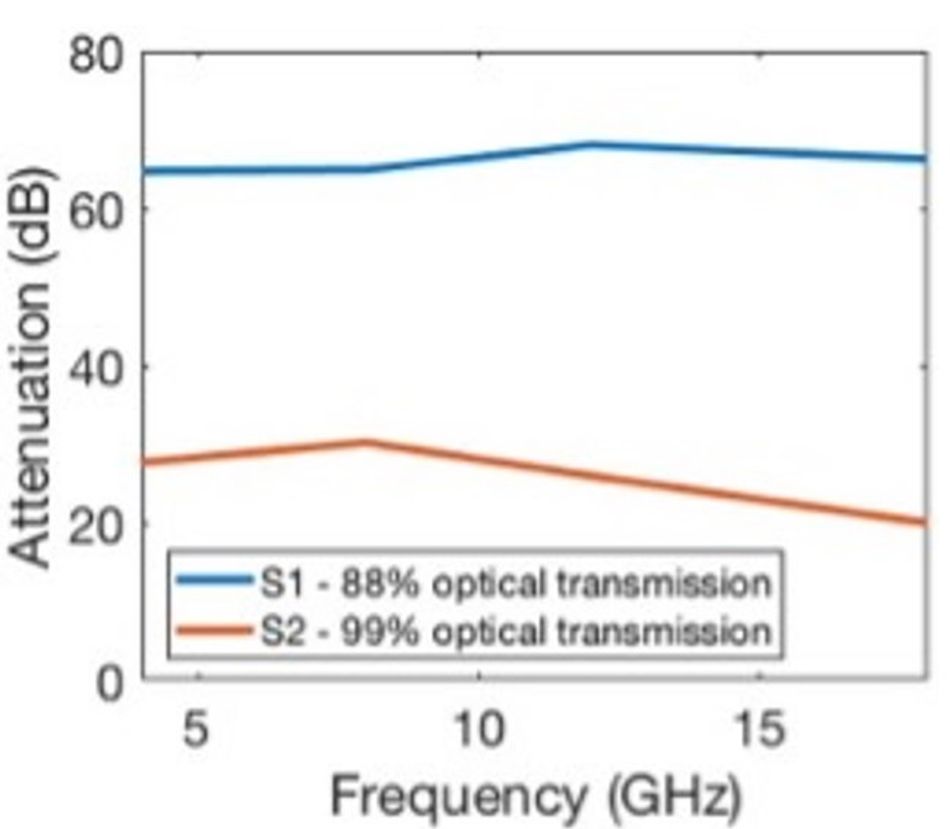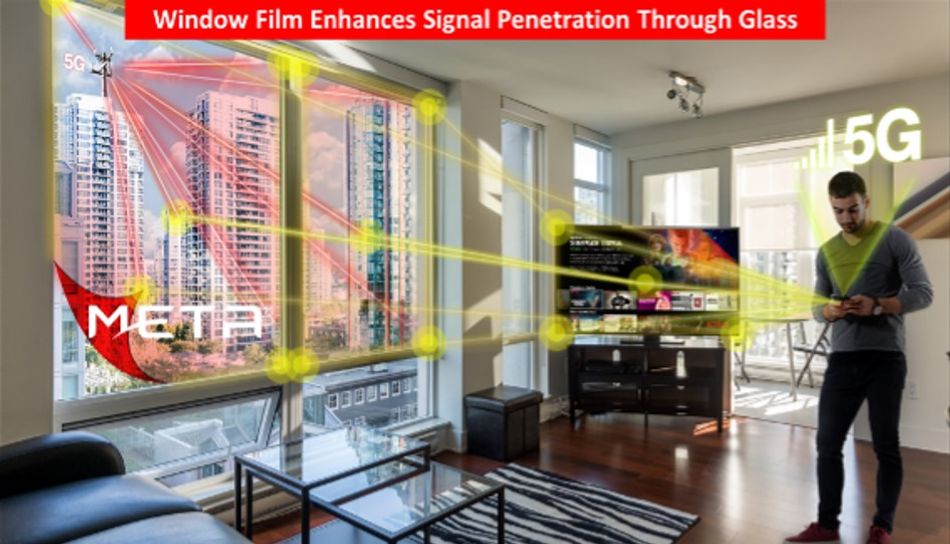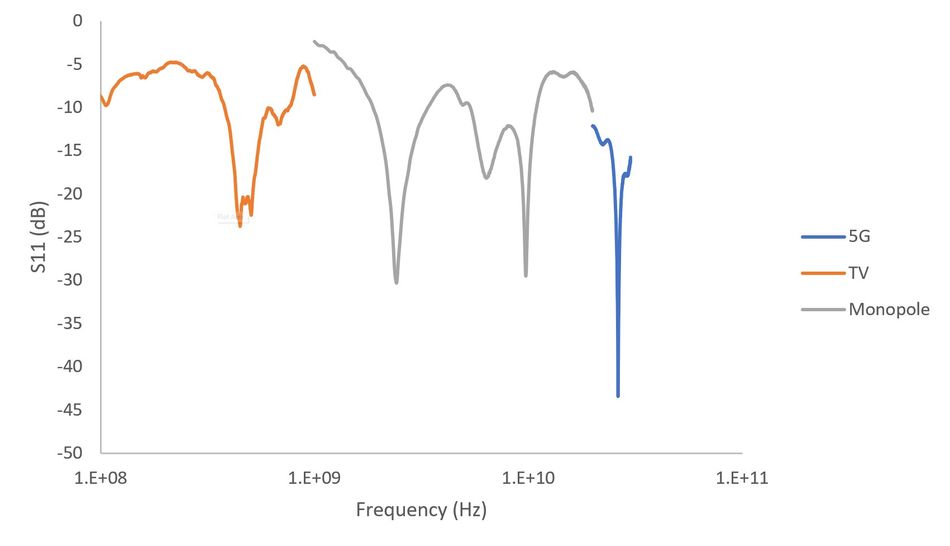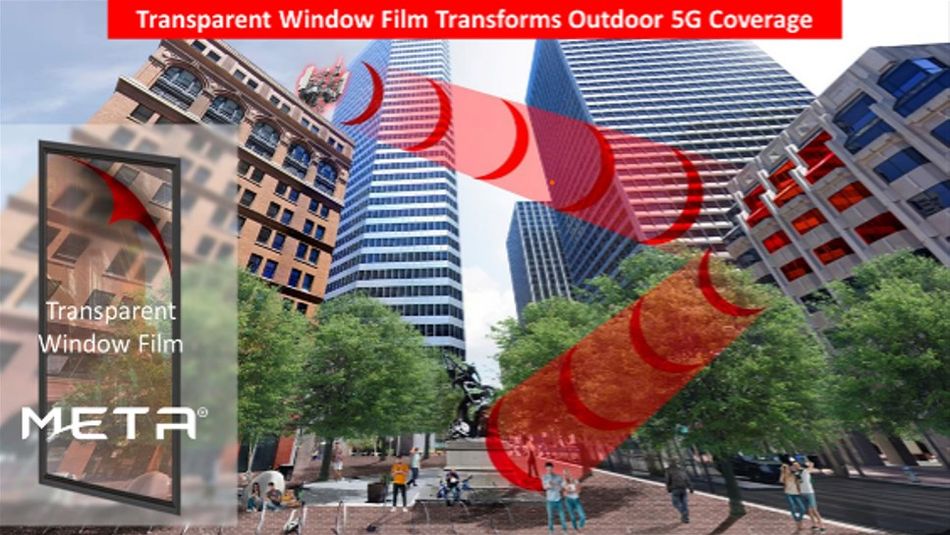NANOWEB - A Revolutionary Transparent Conductive Thin Film
NANOWEB® is an extremely thin, transparent, conductive film that consists of an invisible, nanostructured metal mesh fabricated onto a glass or plastic surface. With its unrivaled transparency, conductivity, and flexibility, this patented functional film holds immense potential for both passive and powered use cases, with applications including electromagnetic interference shielding, antennas, 5G/6G redirection systems for elimination of dead spots, and deicing/defogging devices for vehicle windows and eyewear.
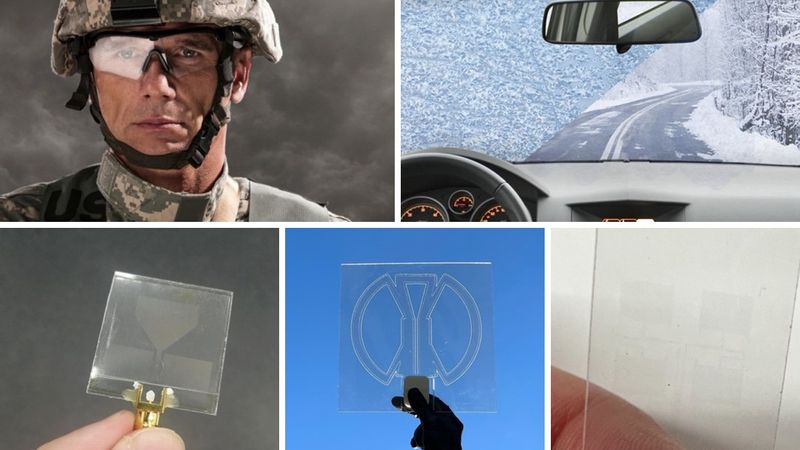
Examples of three NANOWEB® transparent antennas
Executive summary
NANOWEB® is an extremely thin, transparent, conductive film that consists of an invisible, nanostructured metal mesh fabricated onto a glass or plastic surface. With its unrivaled transparency, conductivity, and flexibility, this patented functional film holds immense potential for both passive and powered use cases, with applications including electromagnetic interference shielding, antennas, 5G/6G redirection systems for elimination of dead spots, and deicing/defogging devices for vehicle windows and eyewear.
NANOWEB® technology
Transparent conductors are critical components in a wide range of electronic devices, including touchscreens, organic light-emitting diodes (OLEDs), and photovoltaics. They also find frequent use in the optical components of sensors and display systems, including electromagnetic interference (EMI) shielding and transparent heating elements.
Existing transparent conductive electrode (TCE) materials, such as indium tin oxide (ITO) and silver nanowires, suffer from several drawbacks, including poor mechanical stability, low optical transmissivity, low electrical conductivity, high cost, and limited supply. These constraints (or limitations), together with the ever-growing demand for electronic products, have encouraged efforts to explore alternative solutions.
One outcome of such efforts is NANOWEB®, a unique transparent thin-film conductor developed by Meta Materials Inc. (META®) and winner of the IDTechEx “Best Manufacturing Technology” award.
Comprising a precisely arranged mesh of invisible submicron metal wires formed on a glass or plastic substrate, NANOWEB® offers superior electrical and optical properties compared to conventional transparent conductor films.
Distinct from currently available options, NANOWEB®’s transparency is determined by its nanostructured wire mesh geometric spacing and submicron dimensions. As a result, NANOWEB® can be manufactured from almost any metal, including but not limited to silver, aluminum, nickel, copper, and platinum, all to deliver expansive specifications and capabilities, while maintaining exceptional visibility. A sample of NANOWEB® printed on a circular substrate is shown in Figure 1, which clearly demonstrates its transparency.
Figure 1. A sample printed on a circular substrate as an example of NANOWEB®’s transparency
In many cases, NANOWEB® can function as a substitute for ITO, which is arguably the most commonly used TCE material. A comparison with commercially available TCE technologies, as shown in Figure 2, clearly illustrates NANOWEB®’s superiority in optical transmission versus sheet resistance performance.
Figure 2. Performance comparison of NANOWEB® and ITO and major ITO-alternative TCE technologies
Furthermore, NANOWEB® also outperforms ITO-based components in terms of sustainability and manufacturing energy consumption. Fabricating ITO-based TCEs requires scarce materials and energy-demanding processes. In contrast, NANOWEB® is manufactured from more readily available materials (e.g., silver and copper) and with less energy-intensive tools (e.g., spin coaters and metallization chambers) that are widely available in the industry and provide sustainable performance.
Another key advantage that differentiates NANOWEB® from conventional solutions is its flexible mesh pattern design that can be customized and optimized to satisfy various application requirements. It is often impossible to cost-effectively pattern (etch) ITO much less than 20 µm in thickness, whereas NANOWEB® is printed from its roll-to-roll manufacturing line (not requiring any post-patterning etch step) with submicron features.
NANOWEB® fabrication—Rolling Mask Lithography (RML®)
NANOWEB®’s outstanding performance and versatility can be largely ascribed to its fabrication process called Rolling Mask Lithography (RML®), which may be best described as a proprietary continuous near-field optical nanolithography process. Combining the benefits of phase-shift and soft lithography with roll-to-roll patterning[2,3,4] RML® provides a unique capability to produce subwavelength structures for large-area applications in a cost-effective, scalable fashion. Through the use of a cylindrical elastomeric mask, a wide selection of materials (e.g., silver, gold, and copper) can be fabricated on both rigid (e.g., glass and sapphire) and flexible (e.g., plastic and flexible glass) substrates.
Figure 3(a) illustrates the RML® technique for continuous nanopatterning over a large area and the main system components. Figure 3(b) and (c) show scanning electron microscopy (SEM) images of a NANOWEB® pattern fabricated using a mask 500 nm in mesh linewidth.
Figure 3. (a) Artist’s impression of the RML® technique. (b) and (c) SEM images of a NANOWEB® pattern fabricated using RML®.
The RML® process involves an exposure tool that consists of an in-line ultraviolet (UV) light source enclosed by a quartz cylinder, a soft mask made of a compliant material and featuring a phase-shift pattern, and a substrate coated with a hard, thin, photosensitive resist layer. The mask is mounted over the cylinder and contacts the resist on the substrate, using precise pressure.
During the exposure process, collimated UV light emanating from the UV light source is guided through an intervening slit in front of the mask and into the resist. The phase-shift pattern of the mask facilitates resist exposure in the near field of the patterned UV light. Subsequently, the resist is developed, and the substrate is rinsed.
The linewidth, thickness, and mesh design parameters of the mask used in the RML® process is normally tuned to meet individual transparency and conductivity requirements.
With its high conductivity and best-in-class optical transparency including low haze, NANOWEB® can serve a broad range of both passive and powered applications, some of which are reviewed below.
Register now: www.TechBlick.com/PV2022
NANOWEB® application—EMI shielding
The increasing use of electronic devices has intensified the concern for EMI, which is unwanted noise or interference in an electrical path or circuit caused by an outside source. Also known as radio-frequency (RF) interference, EMI can cause electronics to operate poorly, malfunction, or stop working completely and poses a threat to both electronic equipment and the human body. EMI shielding is a common technology used to minimize the adverse effects of EMI.[6,7,8,9]
For optically transparent systems (e.g., windows and microwave oven doors), one major challenge facing EMI shielding is to ensure optical transmittance while realizing effective shielding[10].
Current transparent EMI shielding systems rely mostly on transparent conductive oxides (TCOs) or metallic wire meshes (MWMs). Dopant-density-limited conductivity precludes TCOs (e.g., ITO) from achieving adequate shielding effectiveness (SE)[11]. On the other hand, owing to their excellent SE and transparency, MWMs are a time-tested, reliable choice of EMI shielding, particularly for microwave-range interference[12]. The applicability of available MWMs is, however, circumscribed by their linewidths, which are large enough (several microns) to be resolved by the human eye.
RML® can effectively address the problem of discernible wires associated with the current MWM-based EMI shielding technology. Typically featuring a linewidth that does not exceed one micron, NANOWEB® fabricated using RML® is impossible to see with the naked eye, thereby offering a significant transparency improvement on industry-standard perforated metal screens or micron-scale MWMs. Figure 4 compares the transparency of a conventional microwave oven and a NANOWEB®-shielded microwave oven. The clear NANOWEB®-based EMI shielding of the latter allows a completely unobstructed view of the food being cooked, forgoing the common need to repeatedly open and close the door to check food readiness.
Figure 4. Transparency improvement achieved with NANOWEB®-based EMI shielding for conventional microwave ovens
With respect to SE, NANOWEB® also outstrips conventional MWMs comparable in transparency. Figure 5 shows the SE measurements for two NANOWEB® designs, S1 and S2. It is apparent that the high (60–70 dB) EMI shielding capability of S1 is not achieved at the expense of optical transparency (approximately 90%).
Figure 5. Measured EMI shielding levels for two NANOWEB® designs
NANOWEB® application—transparent antennas
Another notable application of NANOWEB® is optically transparent antennas. Transparent antennas are useful for integrating antenna functionality into transparent surfaces, such as windshields and windows (Figure 6), while maintaining visibility.
Figure 6. Invisible antenna for home 5G and digital TV
High transparency in NANOWEB® transparent antennas is attained without sacrificing their electromagnetic behavior. This key benefit, along with minimum installation space requirements, propels them to the forefront of antenna choices for many application scenarios. They include 5G antennas for smartphones, smartwatches, and vehicles; Bluetooth antennas for wearables and Internet-of-things (IoT) devices; and satellite antennas mounted on solar panels.
Figure 7. Examples of three NANOWEB® transparent antennas each formed on a polyethylene terephthalate (PET) film substrate
Figure 7 shows three working prototypes of transparent antennas developed using NANOWEB®. The leftmost is a monopole antenna, operating at 6–10 GHz. The middle is a large indoor digital television (TV) reception antenna, which operates at 400–800 MHz. It has also been tested successfully in real-world conditions to receive digital TV signals. To the best of META®’s knowledge, this is the largest transparent antenna ever produced for the given transparency level. The rightmost antenna is a four-array element patch that operates at 5G millimeter-wave (mmWave) bands between 26 and 28 GHz and is compatible with modern 5G networks. It consists of a stack of multiple layers bonded together with optically clear adhesive, where NANOWEB® is used for both the backplane and the radiating element.
Measured frequency responses of the antennas are shown in Figure 8. The optical transparency of these prototypes ranges from 82% to 92%.
Figure 8. Measured frequency responses of NANOWEB® transparent antenna prototypes
With both aesthetic and space advantages over traditional opaque and obtrusive options, NANOWEB® transparent antennas, designed for the frequency range from 400 MHz to 92 GHz, are anticipated to play a significant role in next-generation telecommunications infrastructure.
NANOWEB® application—transparent RF redirection films
As the backbone of smart cities, ubiquitous and reliable connectivity relies on extensive, high-performance (5G/6G) wireless cellular networks capable of handling vast numbers of simultaneous connections with low latency and high data speeds.
Known for high directivity, short ranges, and susceptibility to obstruction, RF communication signals present unique challenges for realizing full network coverage in dense urban areas. The increasing adoption of windows made of energy-saving low-emissivity glass in modern buildings also impedes signal transmission as these windows cause considerable signal attenuation.
Countering this impediment, additional network infrastructure is deployed to improve network coverage, but this is a costly and space-demanding approach. Moreover, network towers are becoming increasingly objectionable to city residents, often devaluing their real estate.
Register now: www.TechBlick.com/PV2022
NANOWEB®-based RF redirection films (Figure 9) present a passive and more sustainable alternative solution for eliminating wireless dead spots. Applicable virtually anywhere, these ultra-thin, transparent, and flexible films can selectively transmit and/or reflect signals in the sub-6-GHz and mmWave ranges.
These NANOWEB® films can be imagined as large sheets of metal, which, however, are completely invisible when applied to walls and windows. Because they are passive and do not require a power supply, these films may be retrofitted indoors and outside, shining signal into dead spots that would otherwise require expensive towers or relays. For factories and hospitals where wireless IoT devices and tools are increasingly employed, another added advantage of passive redirection over active signal relay is that the passive solution does not add any electronic signal lag. Traditionally, relaying a 5G signal through a building with many corridors and rooms may add seconds of nonuniform signal delay, an important consideration in circumstances where all IoT devices may need to work in unison.
Figure 9. NANOWEB®-based transparent RF redirection window film concept for 5G communications expansion
NANOWEB® application—deicing/defogging devices
As a one- or two-dimensional nanowire-based film configured as a resistant heater element, NANOWEB® can deliver uniform heat in a variety of novel high-performance applications. From eyeglasses to windshields, the ability to ensure constant visibility in inclement conditions like fog, ice, and snow is ever more critical.
In automotive applications alone, approximately eight million autonomous or semiautonomous vehicles are forecast to hit the road by 2025. There are six levels of driver assistance technology advancements that autonomous vehicles will first have to progress through prior to reaching full autonomy and joining roadways. Next-generation automobiles, especially those now employing advanced driver-assistance system (ADAS) levels 3, 4, and 5, will use twenty or more scanners and sensors, all requiring sensor signal visibility. With growing driver reliance and the ever-pressing demand for vehicle safety, sensor heaters must react fast and be transparent and uniform to ensure maximum signal-to-noise integrity in all inclement conditions.
Owing to its low resistance, NANOWEB® can achieve the power density required for heating applications with low voltage. For example, as a heating element for windows, NANOWEB® can reach up to 70°C in less than a minute with 12 volts or less applied.
Figure 10 illustrates the efficacy of NANOWEB® anti-fog technology. In this demonstration, the left half of a clear surface was covered with a powered NANOWEB® film, while its right half was not. When a mug filled with heated liquid was placed beneath the surface, condensation formed on the right half of the surface, whereas its left half remained clear, lending credence to the effectiveness of the NANOWEB® film at preventing condensation or fogging.
Figure 10. Demonstration of NANOWEB® anti-fog technology
Condensation occurs when water droplets form as warm air comes in contact with a cold surface. This phenomenon is particularly problematic for masks and eyewear as it drastically reduces visibility. Heating can effectively address this problem by eliminating the temperature gradient between the mask/eyewear lenses and the surrounding air. Compared to other film-based heating solutions (e.g., ITO), NANOWEB® is more efficient at defogging due to a heat density as high as over 10,000 W/m2, while maintaining high transparency.
In addition, use of automotive RADAR sensors is completely blocked by conventional ITO heaters, whereas NANOWEB® linear one-dimensional nanowire arrays are polarized, allowing 100% RADAR transmission. These arrays are impossible to be patterned on ITO invisibly. For LIDAR, the high optical transmission afforded by NANOWEB® results in significant signal-to-noise real-world detection, building a higher-resolution point cloud and realizing environmental detection so critical to ADAS level 4 and 5 autonomy.
Examples of anti-fog eyeglasses and a windshield deicing system using NANOWEB® are shown in Figure 11(a) and (b), respectively.
Figure 11. (a) NANOWEB®-based anti-fog eyeglasses. (b) NANOWEB®-based windshield deicing system.
Conclusion
Composed of a precise arrangement of submicron metal wires that are imperceptible to the human eye, META®’s NANOWEB® offers a flexible, cost-effective, and sustainable alternative to conventional transparent conductive materials. Exceptional, highly differentiated electrical and optical properties, combined with complete customizability with Rolling Mask Lithography (RML®) and ready adaptability, make this ultra-thin, transparent, conductive film a breakthrough solution for wide-ranging applications like 5G, automobiles, and consumer products alike. For more information on NANOWEB®, please visit https://metamaterial.com/products/nanoweb/.
About META®
META® delivers previously unachievable performance, across a range of applications, by inventing, designing, developing, and manufacturing sustainable, high-performance, functional materials. Our extensive technology platform enables leading global brands to deliver breakthrough products to their customers in consumer electronics, 5G communications, health and wellness, aerospace, automotive, and clean energy. Our nano-optic metamaterial technology provides anti-counterfeiting security features for government documents and currencies and authentication for brands. Our achievements have been widely recognized, including being named a Lux Research Innovator of the Year in 2021. Learn more at www.metamaterial.com.
ALL PAST & FUTURE EVENTS AS WELL AS MASTERCLASSES WITH A SINGLE ANNUAL PASS
[1] Aizenberg, J., Rogers, J.A., Paul, K.E. and Whitesides, G.M., 1998. Imaging profiles of light intensity in the near field: applications to phase-shift photolithography. Applied optics, 37(11), pp.2145-2152.
[2] Roller nanoimprint lithography. 16, 3926-3928, doi:10.1116/1.590438 (1998).
[3] Ahn, S.H. and Guo, L.J., 2008. High‐speed roll‐to‐roll nanoimprint lithography on flexible plastic substrates. Advanced materials, 20(11), pp.2044-2049.
[4] Kooy, N., Mohamed, K., Pin, L.T. and Guan, O.S., 2014. A review of roll-to-roll nanoimprint lithography. Nanoscale research letters, 9(1), pp.1-13.
[5] Bakker, J. F., Paulides, M. M., Christ, A., Kuster, N., & van Rhoon, G. C. (2010). Assessment of induced SAR in children exposed to electromagnetic plane waves between 10 MHz and 5.6 GHz. Physics in Medicine & Biology, 55(11), 3115.
[6] Han, Y., Lin, J., Liu, Y., Fu, H., Ma, Y., Jin, P. and Tan, J., 2016. Crackle template based metallic mesh with highly homogeneous light transmission for high-performance transparent EMI shielding. Scientific reports, 6(1), pp.1-11.
[7] Thomassin, J.M., Lou, X., Pagnoulle, C., Saib, A., Bednarz, L., Huynen, I., Jérôme, R. and Detrembleur, C., 2007. Multiwalled carbon nanotube/poly (ε-caprolactone) nanocomposites with exceptional electromagnetic interference shielding properties. The Journal of Physical Chemistry C, 111(30), pp.11186-11192.
[8] Ling, J., Zhai, W., Feng, W., Shen, B., Zhang, J. and Zheng, W.G., 2013. Facile preparation of lightweight microcellular polyetherimide/graphene composite foams for electromagnetic interference shielding. ACS applied materials & interfaces, 5(7), pp.2677-2684.
[9] Wen, B., Cao, M., Lu, M., Cao, W., Shi, H., Liu, J., Wang, X., Jin, H., Fang, X., Wang, W. and Yuan, J., 2014. Reduced graphene oxides: light‐weight and high‐efficiency electromagnetic interference shielding at elevated temperatures. Advanced Materials, 26(21), pp.3484-3489.
[10] Hu, M., Gao, J., Dong, Y., Li, K., Shan, G., Yang, S. and Li, R.K.Y., 2012. Flexible transparent PES/silver nanowires/PET sandwich-structured film for high-efficiency electromagnetic interference shielding. Langmuir, 28(18), pp.7101-7106.
[11] Park, S.K., Han, J.I., Moon, D.G. and Kim, W.K., 2003. Mechanical stability of externally deformed indium–tin–oxide films on polymer substrates. Japanese journal of applied physics, 42(2R), p.623.
[12] Ghosh, D.S., Chen, T.L. and Pruneri, V., 2010. High figure-of-merit ultrathin metal transparent electrodes incorporating a conductive grid. Applied Physics Letters, 96(4), p.041109.


